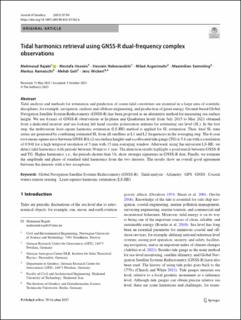| dc.contributor.author | Rajabi, Mahmoud | |
| dc.contributor.author | Hoseini, Mostafa | |
| dc.contributor.author | Nahavandchi, Hossein | |
| dc.contributor.author | Asgarimehr, Milad | |
| dc.contributor.author | Semmling, Maximilian | |
| dc.contributor.author | Ramatschi, Markus | |
| dc.contributor.author | Goli, Mehdi | |
| dc.contributor.author | Wickert, Jens | |
| dc.date.accessioned | 2023-11-01T07:55:58Z | |
| dc.date.available | 2023-11-01T07:55:58Z | |
| dc.date.created | 2023-10-31T15:56:16Z | |
| dc.date.issued | 2023 | |
| dc.identifier.citation | Journal of Geodesy. 2023, 97 (94), . | en_US |
| dc.identifier.issn | 0949-7714 | |
| dc.identifier.uri | https://hdl.handle.net/11250/3099892 | |
| dc.description.abstract | Tidal analysis and methods for estimation and prediction of ocean tidal constitutes are essential in a large area of scientific disciplines, for example, navigation, onshore and offshore engineering, and production of green energy. Ground-based Global Navigation Satellite System-Reflectometry (GNSS-R) has been proposed as an alternative method for measuring sea surface height. We use 6 years of GNSS-R observations at In-phase and Quadrature levels from July 2015 to May 2021 obtained from a dedicated receiver and sea-looking left hand circular polarization antenna for estimating sea level (SL). In the first step, the multivariate least-square harmonic estimation (LS-HE) method is applied for SL estimation. Then, final SL time series are generated by combining estimated SL from all satellites at L1 and L2 frequencies in the averaging step. The 6-year root-mean-square error between GNSS-R L12 sea surface heights and a collocated tide gauge (TG) is 5.8 cm with a correlation of 0.948 for a high temporal resolution of 5 min with 15 min averaging window. Afterward, using the univariate LS-HE, we detect tidal harmonics with periods between 30 min to 1 year. The detection results highlight a good match between GNSS-R and TG. Higher harmonics, i.e., the periods shorter than 3 h, show stronger signatures in GNSS-R data. Finally, we estimate the amplitude and phase of standard tidal harmonics from the two datasets. The results show an overall good agreement between the datasets with a few exceptions. | en_US |
| dc.description.abstract | Tidal harmonics retrieval using GNSS-R dual-frequency complex observations | en_US |
| dc.language.iso | eng | en_US |
| dc.publisher | Springer | en_US |
| dc.rights | Navngivelse 4.0 Internasjonal | * |
| dc.rights.uri | http://creativecommons.org/licenses/by/4.0/deed.no | * |
| dc.subject | Tidevann | en_US |
| dc.subject | Tide | en_US |
| dc.subject | GPS | en_US |
| dc.subject | GPS | en_US |
| dc.subject | Altimetri | en_US |
| dc.subject | Altimetry | en_US |
| dc.subject | GNSS Reflectometri | en_US |
| dc.subject | GNSS Reflectometry | en_US |
| dc.title | Tidal harmonics retrieval using GNSS-R dual-frequency complex observations | en_US |
| dc.title.alternative | Tidal harmonics retrieval using GNSS-R dual-frequency complex observations | en_US |
| dc.type | Peer reviewed | en_US |
| dc.type | Journal article | en_US |
| dc.description.version | publishedVersion | en_US |
| dc.subject.nsi | VDP::Teknologi: 500 | en_US |
| dc.subject.nsi | VDP::Technology: 500 | en_US |
| dc.source.pagenumber | 13 | en_US |
| dc.source.volume | 97 | en_US |
| dc.source.journal | Journal of Geodesy | en_US |
| dc.source.issue | 94 | en_US |
| dc.identifier.doi | https://doi.org/10.1007/s00190-023-01782-6 | |
| dc.identifier.cristin | 2190666 | |
| cristin.ispublished | true | |
| cristin.fulltext | original | |
| cristin.qualitycode | 1 | |

